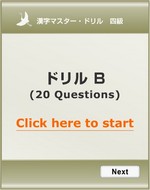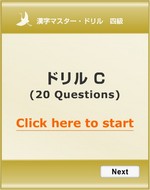Part 1: 人 日 月 火 水 木 金 土 今 何
Read this page briefly and spend most of your time on the drill exercise for quick memorization.
人 : ジン、ニン、ひと
Reading of the Kanji is shown above. Onyomi is in Katakana, Kunyomi is in Hiragana.
|
Meaning: person Shape: Symbolizing the shape of a person.
|
Click to see the stroke order animation.
| Word | Reading | Meaning | Class |
|---|---|---|---|
| ~人 | ~じん | person from _ (nationality) | suffix |
がいこく人<foreigner> にほん人<Japanese person>, カナダ人<Canadian person> |
|||
| ~人 | ~にん | counter for persons | suffix |
3人<3 persons>, 5人<5 persons> |
|||
| 人 | ひと | person | n |
あの人<that person> この人たち<these people> |
|||
日 : ジツ、ニチ、か、ひ
The reading which will be learned in the higher levels is colored in gray.
|
Meaning: the sun, day Shape: Symbolizing the shape of the sun.
|
| 日[曜]日 | にちようび | Sunday | n |
| [誕]生日 | たんじょうび | birthday | n |
| ~日 | ~にち | _th day, _days | suffix |
Numbers + 日(にち) can mean both date and duration. 15日に いきます。<I go on the 15th.> 15日 かかります。<It takes 15 days.> |
|||
Kanji symbols in [ ] will be learned in the higher levels. But it would be good if you can read it. Because the word is usually written in Kanji, not in Hiragana.
Notes
Each day of the week is related to one of 7 planets and stars in the solar system - 日<sun>, 月<moon>, 火星<Mars>, 水星<Mercury>, 木星<Jupiter>, 金星<Venus> and 土星<Saturn>.
月 : ガツ、ゲツ、つき
|
Meaning: the moon, month Shape: Symbolizing the shape of crescent moon.
|
| 月[曜]日 | げつようび | Monday | n |
| ~月 | ~がつ | _ th month of the year | suffix |
1月<January>, 2月<February>, 3月<March> ... |
|||
| ~か月 | ~かげつ | _ months (duration) | suffix |
1か月<1 month>, 2か月<2 months>, 3か月<3 months> ... Other spellings ~ヵ月 and ~ヶ月 are also used. The reading and the meaning are the same. |
|||
| 月 | つき | moon | n |
火 : カ、ひ、ほ
|
Meaning: fire Shape: Symbolizing the shape of flame.
|
| 火[曜]日 | かようび | Tuesday | n |
| 火 | ひ | fire | n |
水 : スイ、みず
|
Meaning: water Shape: Symbolizing the flowing water.
|
| 水[曜]日 | すいようび | Wednesday | n |
| 水 | みず | water | n |
木 : ボク、モク、き、こ
|
Meaning: tree, wood Shape: Symbolizing a tree with branches.
|
| 木[曜]日 | もくようび | Thursday | n |
| 木 | き | tree | n |
金 : キン、コン、かな、かね
|
Meaning: gold, money
|
| 金[曜]日 | きんようび | Friday | n |
| お金 | おかね | money | n |
土 : ト、ド、つち
|
Meaning: earth, soil
|
| 土[曜]日 | どようび | Saturday | n |
| 土 | つち | earth, soil | n |
今 : キン、コン、いま
|
Meaning: now, present
|
| 今 | いま | now | n |
| 今日 | きょう | today | n |
| 今月 | こんげつ | this month | n |
何 : カ、なに、なん
|
Meaning: what
|
| 何 | なに, なん | what | pronoun |
There are two ways of reading なに and なん. 何(なに)をしますか。<What do you do?> これは何(なん)ですか。<What's this?> |
|||
| 何人 | なんにん | how many people? | n |
| 何日 | なんにち | what day? how many days? | n |
何日 can mean both date and duration. 今日は何日ですか。<What date is it today?> 何日かかりますか。<How many days does it take?> |
|||
| 何[曜]日 | なんようび | which day of the week? | n |
| 何月 | なんがつ | which month? | n |
| 何か月 | なんかげつ | how many month? | n |
| 何~ | なん~ | what + unit for counting | prefix |
It can be applied for different units such as 何さい<age>, 何かい<floor>, etc. |
|||
Writing Practice
Handwriting practice improves your character recognition ability.
It is recommended to do the writing practice to get familiar with the shape of letters.
Printable writing practice sheet is available at Kanji Writing Practice page.
Reading of Kanji
Most Kanji symbols have two ways of reading - onyomi and kunyomi.
Onyomi
Onyomi<音読み> is based on the original Chinese pronunciation.
For example, pronunciation of 水 in (ancient) Chinese was "sui". So sui became one way of reading 水.
In many cases, pronuncaton of Japanese onyomi and modern Chinese language are different. Because Japanese incorporated the pronunciation of ancient Chinese.
In general, onyomi is indicated in Katakana in the dictionary.
Kunyomi
Kunyomi<訓読み> is the pronunciation of Japanese word which has the same meaning as the Kanji symbol.
For example, Kanji 水 means water. Japanese word for water was "mizu". So mizu became another way of reading 水.
In general, kunyomi is indicated in hiragana in the dictionary.
How to learn the reading
It is recommended to learn the reading of each word, rather than memorizing all onyomi and kunyomi of a Kanji.
For example, you should know the following general rules;
When 人 is after the country name, the reading is じん.
When 人 is after numbers, it reads にん.
When 人 is by itself, it reads ひと.


















